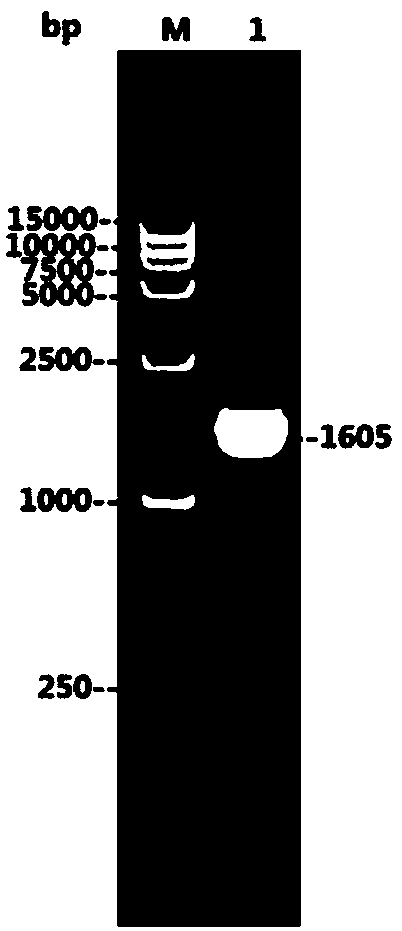Recombinant Newcastle disease virus (NDV) for expressing VP3 gene of new duck parvovirus and application of recombinant NDV
A technology of Newcastle disease virus and duck parvovirus, applied in the field of reverse genetics application, can solve the problem of lack of preparation method of NDPV-VP3 protein
- Summary
- Abstract
- Description
- Claims
- Application Information
AI Technical Summary
Problems solved by technology
Method used
Image
Examples
Embodiment 1
[0031] 1. Construction of recombinant Newcastle disease virus expressing NDPV-VP3
[0032] The NDPV-VP3 gene was amplified by RT-PCR using the Shandong isolate of the new duck parvovirus. Design primers VP3-F and VP3-R with reference to the nucleotide sequence of the new duck parvovirus VP3 gene (GenBank No. KT343253) included in GenBank, and use Trizol reagent to extract NDPV virus RNA, and the fragment size of the amplified product NDPV-VP3 is 1605bp ; The nucleotide sequence of the amplified product NDPV-VP3 is shown in SEQ ID NO:1. The recovered PCR product was connected to pMD18-T-Vector, and it was confirmed by sequencing that NDPV-VP3 was correctly inserted into the vector. The primers are designed as follows:
[0033]
[0034] The NDPV-VP3 gene was connected with the pLMV-RFP linearized vector, and the connected product was transformed into Stbl2 competent cells, and positive clones were screened out to obtain a recombinant NDV virus plasmid expressing NDPV-VP3. ...
Embodiment 2
[0053] A recombinant Newcastle disease virus expressing the novel duck parvovirus VP3 gene, the recombinant Newcastle disease virus is constructed by the following method:
[0054] 1. Construction of recombinant Newcastle disease virus expressing NDPV-VP3
[0055] (1a) The NDPV-VP3 gene was obtained by amplifying the novel duck parvovirus Shandong isolate by RT-PCR method. The recovered PCR product was connected to pMD18-T-Vector, and it was confirmed by sequencing that NDPV-VP3 was correctly inserted into the vector.
[0056] (1b) Ligate the NDPV-VP3 gene with the pLMV-RFP linearized vector, transform the ligated product into Stbl2 competent cells, screen out positive clones, and obtain a recombinant NDV virus plasmid expressing NDPV-VP3.
[0057] More preferably, in the step (1a),
[0058] The primers of the NDPV-VP3 gene PCR amplification are:
[0059] Upstream primer: 5'-ATGGCAGAGGGAGGAGGCGGAGC-3',
[0060] Downstream primer: 5'-TTACAGATTTTGAGTTAGATATCTG-3';
[0061] ...
Embodiment 3
[0079] A recombinant Newcastle disease virus expressing the novel duck parvovirus VP3 gene, the recombinant Newcastle disease virus is constructed by the following method:
[0080] 1) Take duck parvovirus, use RT-PCR method to amplify the NDPV-VP3 gene, recover the PCR product, and connect it to pMD18-T-Vector;
[0081] 2) connecting the NDPV-VP3 gene to the pLMV-RFP linearized vector, and transforming the ligated product into Stbl2 competent cells, screening out positive clones, and obtaining the recombinant NDV virus plasmid;
[0082] 3) Inoculate the recombinant poxvirus vTF7-3 expressing T7 polymerase in a 24-well plate of monolayer BHK-21 cells at a titer of MOI=3, and after incubation for 1 h, pLMV-VP3, pcDNA-NP, pcDNA- P and pcDNA-L plasmids were co-transfected into BHK-21 cells. After 72 hours of transfection, the harvested and rescued recombinant virus was inoculated into 10-day-old SPF chicken embryos, and the chicken embryo allantoic fluid with positive HA and HI te...
PUM
 Login to View More
Login to View More Abstract
Description
Claims
Application Information
 Login to View More
Login to View More - R&D
- Intellectual Property
- Life Sciences
- Materials
- Tech Scout
- Unparalleled Data Quality
- Higher Quality Content
- 60% Fewer Hallucinations
Browse by: Latest US Patents, China's latest patents, Technical Efficacy Thesaurus, Application Domain, Technology Topic, Popular Technical Reports.
© 2025 PatSnap. All rights reserved.Legal|Privacy policy|Modern Slavery Act Transparency Statement|Sitemap|About US| Contact US: help@patsnap.com



